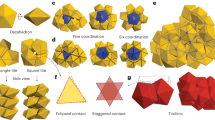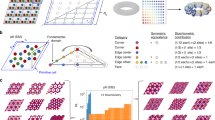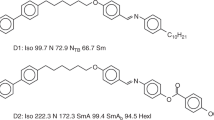Abstract
Chirality is an important element of biology, chemistry and physics. Once symmetry is broken and a handedness is established, biochemical pathways are set. In DNA, the double helix arises from the existence of two competing length scales, one set by the distance between monomers in the sugar backbone, and the other set by the stacking of the base pairs1. Here we use a colloidal system to explore a simple forcing route to chiral structures. To do so we have designed magnetic colloids that, depending on both their shape and induced magnetization, self-assemble with controlled helicity. We model the two length scales with asymmetric colloidal dumbbells linked by a magnetic belt at their waist. In the presence of a magnetic field the belts assemble into a chain and the steric constraints imposed by the asymmetric spheres force the chain to coil. We show that if the size ratio between the spheres is large enough, a single helicity is adopted, right or left. The realization of chiral colloidal clusters opens up a new link between colloidal science and chemistry. These colloidal clusters may also find use as mesopolymers, as optical and light-activated structures2, and as models for enantiomeric separation.
This is a preview of subscription content, access via your institution
Access options
Subscribe to this journal
Receive 51 print issues and online access
$199.00 per year
only $3.90 per issue
Buy this article
- Purchase on Springer Link
- Instant access to full article PDF
Prices may be subject to local taxes which are calculated during checkout




Similar content being viewed by others
References
Watson, J. D. & Crick, F. H. C. A structure for deoxyribose nucleic acid. Nature 171, 737–738 (1953)
Dreyfus, R. et al. Microscopic artificial swimmers. Nature 437, 862–865 (2005)
Leunissen, M. E. et al. Ionic colloidal crystals of oppositely charged particles. Nature 437, 235–240 (2005)
Savage, J. R., Blair, D. W., Levine, A. J., Guyer, R. A. & Dinsmore, A. D. Imaging the sublimation dynamics of colloidal crystallites. Science 314, 795–798 (2006)
Stradner, A. et al. Equilibrium cluster formation in concentrated protein solutions and colloids. Nature 432, 492–495 (2004)
Gasser, U., Weeks, E. R., Schofield, A., Pusey, P. N. & Weitz, D. A. Real-space imaging of nucleation and growth in colloidal crystallization. Science 292, 258–262 (2001)
Bibette, J., Mason, T. G., Gang, H. & Weitz, D. A. Kinetically induced ordering in gelation of emulsions. Phys. Rev. Lett. 69, 981–984 (1992)
Clayden, J., Greeves, N., Warren, S. & Wothers, P. Organic Chemistry 1st edn (Oxford Univ. Press, 2000)
Yin, Y. & Xia, Y. Self-assembly of spherical colloids into helical chains with well-controlled handedness. J. Am. Chem. Soc. 125, 2048–2049 (2003)
Goubault, C., Leal-Calderon, F., Viovy, J. L. & Bibette, J. Self-assembled magnetic nanowires made irreversible by polymer bridging. Langmuir 21, 3725–3729 (2005)
Manoharan, V. N., Elsesser, M. T. & Pine, D. J. Dense packing and symmetry in small clusters of microspheres. Science 301, 483–487 (2003)
Tandon, S., Beleggia, M., Zhu, Y. & De Graef, M. On the computation of the demagnetization tensor for uniformly magnetized particles of arbitrary shape. Part I: Analytical approach. J. Magn. Magn. Mater. 271, 27–38 (2004)
Young, R. J. & Lovell, P. A. Introduction to Polymers 2nd edn (Chapman and Hall, 1991)
Stöber, W., Fink, A. & Bohn, E. Controlled growth of monodisperse silica spheres in the micron size range. J. Colloid Interface Sci. 26, 62–66 (1968)
Zerrouki, D. et al. Preparation of doublet, triangular, and tetrahedral colloidal clusters by controlled emulsification. Langmuir 22, 57–62 (2006)
Acknowledgements
We thank R. Dreyfus for discussions.
Author information
Authors and Affiliations
Corresponding author
Supplementary information
Supplementary Methods
This file contains Supplementary Methods (PDF 182 kb)
Supplementary Movie 1
This file Contains Supplementary Movie 1 (MOV 753 kb)
Supplementary Movie 2
This file Contains Supplementary Movie 2 (MOV 693 kb)
Rights and permissions
About this article
Cite this article
Zerrouki, D., Baudry, J., Pine, D. et al. Chiral colloidal clusters. Nature 455, 380–382 (2008). https://doi.org/10.1038/nature07237
Received:
Accepted:
Issue Date:
DOI: https://doi.org/10.1038/nature07237
This article is cited by
-
Liquid-crystalline behavior on dumbbell-shaped colloids and the observation of chiral blue phases
Nature Communications (2022)
-
Self-assembled inorganic chiral superstructures
Nature Reviews Chemistry (2022)
-
Assembly of planar chiral superlattices from achiral building blocks
Nature Communications (2022)
-
Total synthesis of colloidal matter
Nature Reviews Materials (2021)
-
Straightforward preparation of supramolecular Janus nanorods by hydrogen bonding of end-functionalized polymers
Nature Communications (2020)
Comments
By submitting a comment you agree to abide by our Terms and Community Guidelines. If you find something abusive or that does not comply with our terms or guidelines please flag it as inappropriate.



